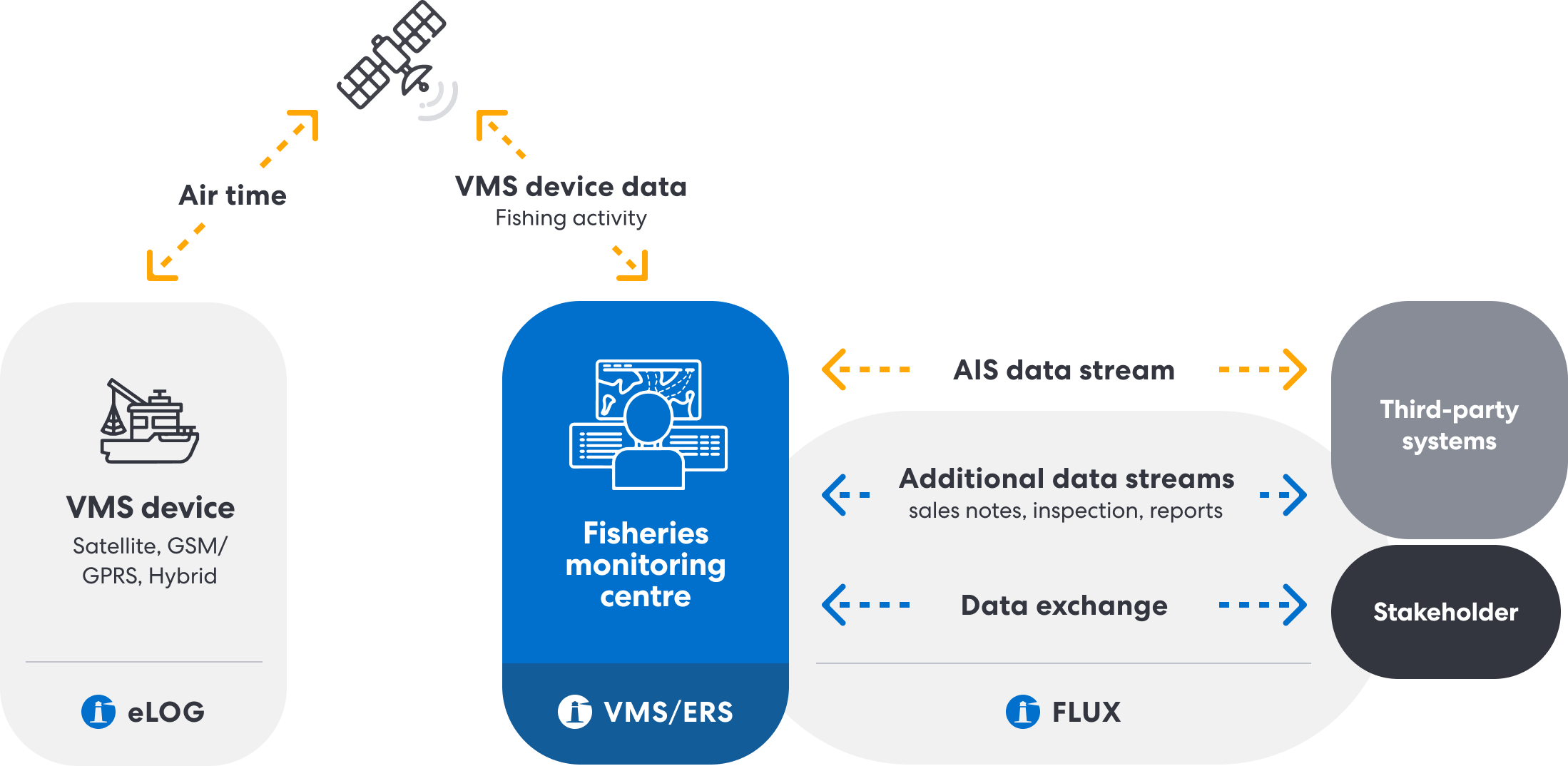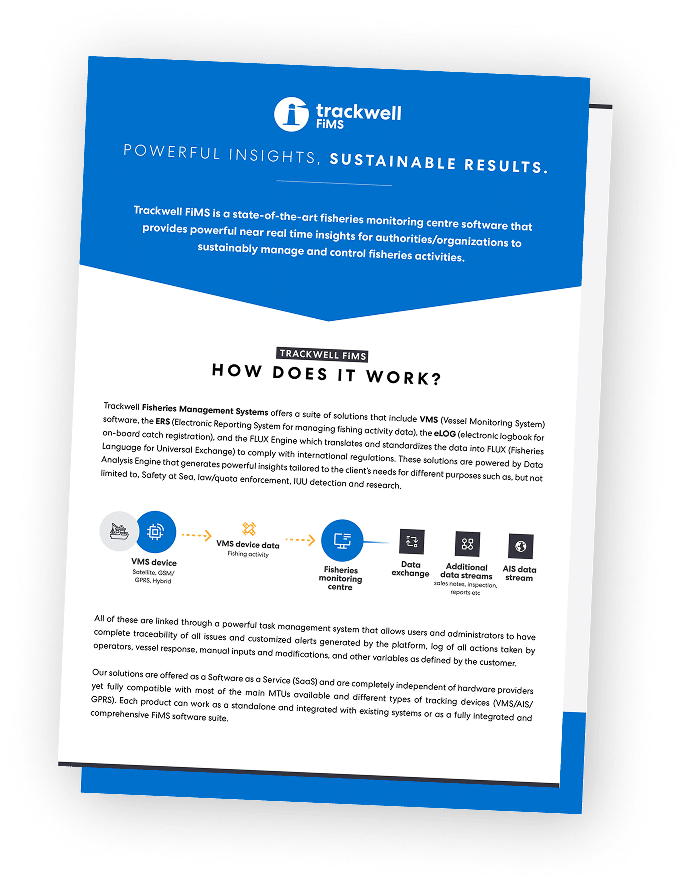Index of content
Understanding how a vessel monitoring system works is essential for modern fisheries management. Authorities need to know where fishing vessels are and what they are doing to ensure compliance and sustainability. The Vessel Monitoring System (VMS) is the core technology that delivers this critical information.
This guide provides a straightforward explanation of the entire VMS ecosystem. We will cover everything from the equipment on the vessel to the software in the control center. You will see how platforms like Trackwell FiMS enable authorities to protect our vital marine resources.
The role of vessel monitoring systems in ocean conservation
At its core, a Vessel Monitoring System (VMS) is a dedicated, satellite-based surveillance solution designed specifically for fisheries management. Unlike public systems like AIS, which can be tampered with, a VMS is a mandatory, secure, and encrypted system for licensed commercial vessels. It provides a constant, reliable stream of data through a seamless process:
- The Onboard Unit: Every designated vessel is equipped with a certified, tamper-proof VMS transponder. This device automatically collects and encrypts crucial data—GPS location, course, and speed—at regular, predetermined intervals.
- The Satellite Bridge: The encrypted data package is transmitted via satellite to a secure server, ensuring constant communication even in the most remote waters, far beyond the reach of cellular networks.
- The Intelligence Hub: The data is then forwarded to a Fisheries Monitoring Center (FMC). Here, powerful software, like Trackwell FiMS, receives, processes, stores and analyzes the information. This is where vessel movements are cross-referenced with regulations, and potential violations are flagged for immediate action.

The power of vessel monitoring in fighting illegal fishing
A modern VMS enables proactive, data-driven enforcement by actively identifying suspicious behavior. By creating a complete and verifiable picture of a vessel’s activity, it empowers authorities to act with confidence.
Automated Geofencing and Zone Alerts: Authorities can establish digital perimeters around any location, such as Marine Protected Areas (MPAs), seasonal closures, or national Exclusive Economic Zones (EEZs). If a vessel enters a restricted zone without authorization, the system triggers an instant alert, enabling a rapid response.
Intelligent Behavioral Analysis: The system is trained to spot red flags that often signal illegal activity. This could be a vessel loitering just outside a restricted area, performing unusual maneuvers consistent with illegal fishing, or meeting another vessel at sea for an unauthorized transshipment of catch—all patterns that would be missed by human eyes alone.
Comprehensive Compliance Verification: The true power of VMS is realized when integrated with other critical data streams. By cross-referencing VMS data with electronic logbooks, fishing licenses, and catch quotas, authorities can easily uncover discrepancies. If a vessel reports fishing in one location but its VMS data proves it was somewhere else, the deception becomes clear and actionable.
Making better fisheries decisions using Trackwell FiMS
A truly effective Vessel Monitoring System for prevention of IUU fishing must do more than just collect data; it must deliver actionable intelligence. Trackwell FiMS is purpose-built to bridge that gap for government agencies and Regional Fisheries Management Organizations (RFMOs).
The platform achieves this by creating a unified compliance ecosystem. It moves beyond simple tracking by seamlessly integrating vessel movement data with electronic logbooks, licensing databases, and quota management tools. This holistic view is powered by an intelligent, automated alerts engine, which authorities can configure to flag everything from unauthorized entry into a protected area to suspicious speed changes.
Furthermore, Trackwell FiMS provides the tools needed for decisive enforcement. For post-incident analysis, officials can use historical replay functions and detailed reporting to build robust, data-driven cases against violators. This power is supported by foundational flexibility; the system is designed to be compatible with a wide range of approved transponders and satellite providers, ensuring it can be scaled effectively to meet national or regional needs.
Building a future for sustainable fisheries management
As illegal fishing operations become more sophisticated, the tools used to fight them must be even more advanced. A Vessel Monitoring System provides the constant, unblinking oversight needed to create a powerful deterrent, transforming vast, ungoverned waters into a managed and accountable space.
By implementing a robust VMS, authorities are not just adopting a technology—they are building a foundation for transparent governance and long-term marine sustainability. Software like Trackwell FiMS provide the critical intelligence layer needed to turn data into outcomes, helping to secure our oceans for generations to come
Frequently asked questions (FAQ)
What is the main difference between VMS and AIS?
The key difference is purpose and security. The Automatic Identification System (AIS) is an open, unencrypted system designed primarily for collision avoidance. Its signals are public and the device can be turned off. A Vessel Monitoring System (VMS) is a closed, encrypted system designed for fisheries regulation. It is tamper-proof, its data is sent privately to fisheries authorities, and it is mandatory for specified fishing vessels.
Is a VMS required on all fishing vessels?
VMS requirements vary by country and fishery. Generally, it is mandatory for larger commercial vessels or those operating under the jurisdiction of an RFMO. However, many authorities are expanding these requirements to include smaller vessels to achieve comprehensive oversight of all fishing activity.
What happens if a VMS transponder stops transmitting?
An unexpected loss of signal immediately raises a red flag at the Fisheries Monitoring Center. An unexplained “gap” in transmission, especially near a restricted zone, is considered highly suspicious and can trigger a targeted patrol or a mandatory inspection upon the vessel’s return to port.
Can VMS data be used as legal evidence?
Absolutely. VMS data is widely accepted as strong, verifiable evidence in legal and administrative proceedings against IUU fishing. The secure, tamper-resistant nature of type-approved VMS hardware makes the data highly reliable for proving a vessel’s location and activity.
How does VMS contribute to sustainable fishing?
By ensuring vessels comply with regulations, VMS is foundational to sustainability. It prevents fishing in protected spawning grounds, enforces seasonal closures that allow stocks to recover, and helps verify that catch quotas are not exceeded. This data-driven enforcement leads to healthier fish stocks and more stable marine ecosystems.
What is Automatic Identification System (AIS)?
AIS, or Automatic Identification System, is a tracking system used on ships and by vessel traffic services for identifying and locating vessels. It operates on Very High Frequency (VHF) and allows vessels to automatically broadcast information, such as a vessel’s identity, type, position, course, speed, navigational status, and other safety-related information.
The AIS units installed on vessels emit a VHF signal with this data in regular intervals. These signals can be received by other nearby vessels, AIS base stations located along coastlines, and by satellite networks. Even though AIS was initially designed for collision avoidance, in the context of Vessel Monitoring Systems (VMS), AIS data can be integrated into the Fishing Monitoring Centre (FMC) software. This allows it to complement the satellite-based VMS data, providing additional insights for effective fisheries management.
What are Electronic Reporting Systems (ERS) and Electronic Logbooks, and how do they integrate into a VMS system?
Electronic Reporting Systems (ERS) are integral modules within the Fishing Monitoring Centre (FMC) software. They provide a digital platform for the management and reporting of fishing activities, as well as integrating other data sources such as sales and inspections reports, thereby enhancing accountability and transparency in fisheries management.
Electronic Logbooks, on the other hand, are separate software applications or apps used onboard vessels to document operational data such as details about catch, gear used, effort, and area of operation.
These systems integrate seamlessly into a VMS, thereby offering a comprehensive view of fishing activities. The integration of data from Electronic Logbooks and other external sources such as sales and inspections with the ERS module in the FMC software results in a more complete and accurate picture of fishing operations. This enhanced data fusion significantly improves the overall effectiveness and efficiency of the VMS system.
What should be considered when choosing a VMS device for a vessel monitoring system?
Choosing the right VMS device is crucial for effective vessel monitoring. Some key considerations include:
- Device reliability, accuracy, and provider’s reputation: Your VMS device should provide precise positional information and various alerts reliably. The provider’s reputation is also essential – they should have a good track record of service and support. The chosen VMS device should be robust enough to withstand the harsh marine environment, and the vendor should offer timely and efficient service to guarantee minimal downtime.
- Communication type and data transmission capabilities: Devices can transmit data through satellite, GPRS, or a hybrid of both. Although hybrid devices are often considered cost-effective due to lower airtime costs, satellite units with motion-based reporting can be equally competitive. The device’s data transmission capabilities and associated service plans should be cost-effective and meet the needs of the fishing vessel’s operating areas.
- Additional features: Depending on the type of fishery and specific regulatory requirements, additional features such as panic buttons for emergency alerts, and solar power for vessels without an available power source can be beneficial.
- Ease of installation and low maintenance: Devices should be easy to install and require minimal to no service. When required, servicing should ideally be done remotely to minimize disruption to fishing operations.
- Compatibility with FMC software: Ensure the device integrates well with your FMC software, converting raw data into actionable insights efficiently.

